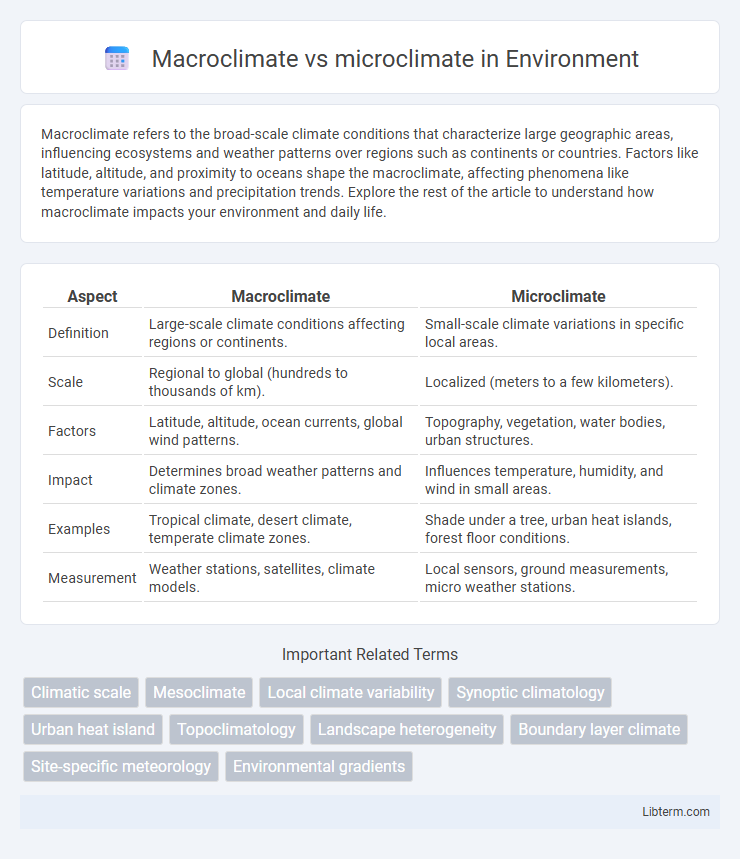Macroclimate refers to the broad-scale climate conditions that characterize large geographic areas, influencing ecosystems and weather patterns over regions such as continents or countries. Factors like latitude, altitude, and proximity to oceans shape the macroclimate, affecting phenomena like temperature variations and precipitation trends. Explore the rest of the article to understand how macroclimate impacts your environment and daily life.
Table of Comparison
| Aspect | Macroclimate | Microclimate |
|---|---|---|
| Definition | Large-scale climate conditions affecting regions or continents. | Small-scale climate variations in specific local areas. |
| Scale | Regional to global (hundreds to thousands of km). | Localized (meters to a few kilometers). |
| Factors | Latitude, altitude, ocean currents, global wind patterns. | Topography, vegetation, water bodies, urban structures. |
| Impact | Determines broad weather patterns and climate zones. | Influences temperature, humidity, and wind in small areas. |
| Examples | Tropical climate, desert climate, temperate climate zones. | Shade under a tree, urban heat islands, forest floor conditions. |
| Measurement | Weather stations, satellites, climate models. | Local sensors, ground measurements, micro weather stations. |
Introduction to Macroclimate and Microclimate
Macroclimate refers to the broad, regional climate patterns influenced by large-scale atmospheric processes, such as prevailing winds, latitude, and ocean currents, shaping weather conditions over extensive geographic areas. In contrast, microclimate encompasses localized climate variations that occur within small areas, like urban neighborhoods, forests, or valleys, driven by factors including vegetation, topography, and human activities. Understanding the distinctions between macroclimate and microclimate is crucial for applications in agriculture, urban planning, and environmental management.
Defining Macroclimate: Broad-Scale Climate Patterns
Macroclimate refers to the broad-scale climate patterns that characterize large geographic regions, typically spanning hundreds to thousands of kilometers. These patterns are influenced by factors such as latitude, altitude, and prevailing wind systems, which determine temperature ranges, precipitation levels, and seasonal variability. Understanding macroclimate is essential for climatology, agriculture, and environmental planning as it provides the general context within which localized microclimates develop.
Understanding Microclimate: Localized Environmental Conditions
Microclimate refers to the localized atmospheric conditions that differ from the surrounding macroclimate due to factors such as terrain, vegetation, and human structures. These small-scale environmental variations influence temperature, humidity, wind patterns, and precipitation within a specific area, affecting plant growth, wildlife habitats, and urban planning. Understanding microclimate is essential for optimizing agriculture, designing sustainable landscapes, and mitigating climate impacts in localized regions.
Key Differences Between Macroclimate and Microclimate
Macroclimate refers to the overall climate conditions of a large geographic area, such as a region or country, influenced by factors like latitude, altitude, and ocean currents, while microclimate describes the localized climate variations within a small area, such as a garden, city block, or valley, affected by surface features and human activities. Key differences include spatial scale, with macroclimate covering extensive regions and microclimate confined to limited zones, and temporal stability, where macroclimates change slowly over decades or centuries, whereas microclimates can vary rapidly due to immediate environmental changes. Understanding these distinctions is crucial for applications in agriculture, urban planning, and ecology, where specific climate characteristics impact plant growth, weather predictions, and habitat suitability.
Factors Influencing Macroclimate
Macroclimate encompasses large-scale atmospheric conditions influenced by latitude, altitude, and proximity to oceans, which regulate temperature and precipitation patterns over vast regions. Seasonal variations in solar radiation and global wind currents further modify macroclimatic zones, shaping biomes and ecosystems. Understanding these factors is crucial for predicting long-term weather trends and climate-related ecological impacts.
Factors Shaping Microclimate
Microclimate is primarily shaped by localized factors including topography, vegetation, water bodies, and human structures that influence temperature, humidity, and wind patterns within a small area. Soil composition and color affect heat absorption and retention, while shading from trees or buildings can significantly reduce temperatures compared to the surrounding macroclimate. Urbanization often creates heat islands by increasing surfaces that absorb and re-emit solar radiation, demonstrating how microclimate can diverge sharply from the broader regional macroclimate.
Importance of Macroclimate in Ecosystem Dynamics
Macroclimate shapes broad environmental conditions such as temperature, precipitation, and seasonal patterns that regulate ecosystem processes and biodiversity at regional scales. These large-scale climatic factors influence species distributions, ecosystem productivity, and biogeochemical cycles, driving long-term ecological dynamics. Understanding macroclimate is essential for predicting ecosystem responses to climate change and managing natural resources effectively.
Microclimate Impacts on Local Flora and Fauna
Microclimates create unique environmental conditions that significantly influence local flora and fauna by providing varied temperature, moisture, and sunlight patterns distinct from the surrounding macroclimate. These specific conditions allow the survival of specialized plant species and animal populations that might not thrive under broader climate trends, fostering biodiversity within ecosystems. Microclimate variations can affect phenology, reproduction cycles, and habitat suitability, ultimately shaping community composition and ecological resilience.
Human Influence on Macroclimate and Microclimate
Human activities significantly alter macroclimate patterns by increasing greenhouse gas emissions, leading to global warming and widespread shifts in temperature and precipitation. Urbanization modifies microclimates through heat island effects, changing local temperature, humidity, and wind flow within cities. Land-use changes such as deforestation and agriculture impact both macro- and microclimates by altering surface albedo and evapotranspiration rates, disrupting natural climate regulation.
Practical Applications: Managing Microclimates for Agriculture and Urban Planning
Managing microclimates in agriculture involves manipulating factors such as soil moisture, shade, and wind barriers to optimize crop yields and reduce pest risks, enhancing overall farm productivity. Urban planners use microclimate data to design green spaces, improve air circulation, and implement heat island mitigation strategies, promoting healthier and more comfortable living environments. Understanding the distinctions between macroclimate and microclimate enables targeted interventions that address localized climate variations effectively in both agricultural and urban contexts.
Macroclimate Infographic

 libterm.com
libterm.com